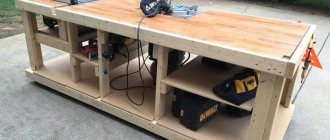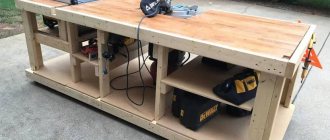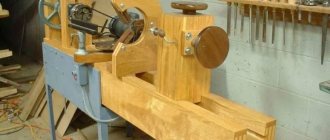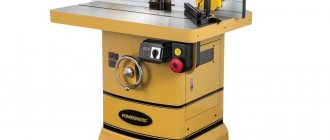Using homemade machines in the workshop
The work that is performed in the workshop affects the equipment of the room with special devices. Typically, equipment is placed if the free area is at least 3 m2.
Workshops are often set up in small rooms, outbuildings, and garages. The best place is a separate building. In this case, the noise from the work being performed will not disturb other residents of the house.
Universal workshops are often set up to perform various jobs. If a person is engaged in the production of any products, then specific homemade tools and devices are made. Often workshops are equipped with machines for carpentry and processing of metal blanks. Often, premises for the repair of wheeled vehicles are also set up.
Basically the workshop is equipped with:
- devices that allow you to prepare tools, facilitate labor and mechanize operations;
- homemade products for processing metal parts;
- workbenches.
A workbench made of wooden elements Source skilljob.ru
It is also necessary to install shelves in the room where various tools will be stored. At the same time, they ensure unhindered access to them and compliance with fire safety rules.
GARDEN TOOLS
The dacha area is that separate world that often pushes us to inventions.
And it’s understandable, because there is a huge amount of work that needs to be done quickly, efficiently, and without much investment. Therefore, today we are studying a cunning garden tool created with our own hands. Our sheds are full of special country tools - shovels and pruning shears, scissors and brush cutters, hoes and axes, hacksaws and pitchforks, and what about the Fokina flat cutter... but there are also more abstruse and modern tools - an angle grinder, a drill, a chainsaw.
But all this is definitely not enough to do all the necessary work. No, everything is real, but who wants to spend a lot of time clearing the garden of young growth, removing weeds from the spring garden, or doing other, even more mundane work, if it is possible to quickly cope with the task? Today we will give you something to think about, because making smart and modernized garden tools with your own hands is not difficult, but very useful. So, let's go in order and look at all the new products and older inventions, which, by the way, half of us have never heard of!
Contents of the material
Workbench for a carpenter
This type of equipment is a table. It is distinguished by its high strength and the presence of 2 vices on the tabletop. The table is also equipped with clamps that clamp the workpieces during planing. In addition, the workbench may still have places where other homemade devices, such as a router, will be attached.
A special table must have a comfortable height. She matches the height of the master. The minimum length of the workbench is 1000 mm. Often it is equal to 1700 mm or even 2000 mm. The standard width is 800 mm.
Before making a workbench for carpentry, get acquainted with its main parts Source infourok.ru
A workbench table is created as follows:
- The table surface is created - this is a shield, which is made from oak, beech or hornbeam boards with a minimum thickness of 55 mm. They are tightly fitted to each other. The boards used are impregnated with drying oil before joining. To create a rigid structure, a 50 mm block is used. It is fixed around the perimeter of the working surface.
- The supporting elements of the workbench are made. To do this, use linden or pine timber. Its size is 120*120 mm or 150*150 mm, and its length is approximately 1200 mm. The supports are connected by jumpers in the horizontal plane. To do this, take boards that are fixed at a distance of 300 mm from the floor.
- Make homemade devices to accommodate the tool. These are shelves located under the countertop. When they are open, they are often replaced with bedside tables.
- Attach a vice.
If a stationary workbench is created, its supporting elements are fixed to the floor. Depending on the specifics of the work being performed, mobile and collapsible tables are also manufactured.
Mobile workbench on wheels Source foamin.ru
Carpenter's workbench vice
This homemade tool is made using a screw rod. Its thread length must be at least 160 mm. In this case, the diameter of the rod itself must be 20 mm. For the vice you will also need wooden blocks and metal pins. The manufacturing sequence is as follows:
- Prepare a block of 200*300 mm. Its minimum thickness should be 50 mm. This will be one of the sponges. A hole for a screw is drilled in the center of the workpiece. On the sides of it, two more holes are made for the studs.
- A second movable jaw 200*180 mm is cut out and similar holes are drilled in it.
- A threaded pin is inserted into the workpiece. A handle is installed at one end. To prevent the jaws from moving, pins with a cross section of 10 mm are passed through other holes.
Wooden vice for a carpenter Source infradom.ru
How to make a dryer for fruits and vegetables?
Look at what materials you need to take for this:
- sheet metal;
- square pipes;
- locking mechanism;
- polycarbonate sheet;
- self-tapping screws;
- 2 door hinges.
Here are the tools you need to equip yourself with:
- grinder;
- welding machine;
- drill;
- stationery knife;
- tape measure and marker;
- metal scissors;
- with a hacksaw.
First you need to make the base for the drying cabinet. Make a frame from square pipes. Horizontal and vertical posts are sawed off so that the edges are smooth. And the ends on the connecting elements should be beveled.
The door here will be metal. To make it, cut 4 fragments from an iron pipe and weld them into a rectangle. Then you need to sheathe this base with metal using screws with nuts and self-tapping screws. If possible, weld a steel sheet. To make a mount for baking sheets, attach wooden blocks to the back of the frame. Take self-tapping screws for this. In this case, on each side there are 4 wooden blocks for 4 baking sheets.
An absorber is installed in the dryer. Take some sheet metal and paint it black. Use heat-resistant paint. When it is dry, place this blank on the bottom of the dryer. For the absorber, take a thick aluminum or copper sheet, or, in extreme cases, steel. These materials conduct heat well.
Now you need to sheathe the outside of the dryer, make the roof transparent, made of polycarbonate. Then the sun's rays will penetrate well here. Glass can also be used. Cover the ventilation windows with a mosquito net to prevent insects from flying in.
Attach hinges and a locking mechanism to the door. Secure the door in place. Look what a wonderful, beautiful and spacious dryer it turned out to be.
All that remains is to make the baking sheets. They must allow air to pass through. First, knock together the frames from the bars, and then attach the metal mesh to them.
Now you can cut fruit and watch how your device will work. Place a thermometer in the dryer to monitor the temperature. It should be between 50–55°C. At lower temperatures, cover the bottom holes by placing a rag here.
In such a homemade dryer you can dry not only fruits, but also vegetables, herbs, fish, meat, and roots.
If this design diagram for such a device seems complicated to you, then you can make a dryer from a metal barrel. A hole for the door is cut out in it, and metal mesh racks are inserted inside.
To prevent water from flowing in here and for better ventilation, a roof like this is installed on top.
You can upgrade this fixture by installing a fan and an electric heater inside.
If you want to make your own lawn mower, then this is also possible.
Turn an old washing machine into it, for example, like this one.
And if you still have an old bedside table, then you can turn it into a platform for a future almost self-propelled device. But you only need the door from the bedside table.
Drill holes in the center of the motor shaft. Make a cutting knife from an old two-handed saw. It is necessary to saw off it to the size of the desired shape, cut out a recess inside.
To make it convenient to transport the lawn mower, take wheels from the same old washing machine. These will become the rear wheels of the mower.
And you can take the front ones from a baby stroller.
To avoid bumping into fences and other obstacles with your knife when mowing, place the front wheels so that they protrude slightly beyond the knife.
Cover the electric motor with a casing cut from a plastic container.
Attach two wooden pickets that will become the handles of the mower. Don't forget to secure the motor and extension cord to it. Now you can test such an interesting unit.
If you are interested in other homemade products for the garden, then you will find it useful to watch the following video.
Many interesting ideas await you in the first video. And you can get acquainted with cool homemade products made from plastic pipes if you watch the second story.
Metal workbench for a mechanic
All useful homemade products and devices simplify the processing of workpieces. Such devices include a workbench for a mechanic. Its minimum dimensions are:
- length – 1800 mm;
- width – 700 mm;
- height – 900 mm.
The table is created in the following sequence:
- frame assembly;
- installation of 2 cabinets, covered with metal;
- securing a working surface consisting of a wooden base in the form of a shield, on which a sheet of metal of a suitable size is placed on top;
- assembly and installation of a rack at the back of the workbench to strengthen the entire structure and accommodate tools.
When assembling a bench, use:
- beams as racks - four corrugated pipes 40*60 mm with a wall thickness of at least 2 mm;
- three beams 50*40 mm to connect the racks and ensure longitudinal rigidity of the structure;
- corrugated pipe 40*30 mm with a wall of at least 1 mm in the amount of 9 pieces to create the frame of the cabinets;
- metal corner 50*50 mm for the manufacture of shelving racks, the height of which will be a maximum of 2000 mm;
- board 50 mm thick for the tabletop panel;
- a sheet of metal no thinner than 6 mm to cover the top surface of the workbench.
Sheet metal Source glavmetall.com
See also: Catalog of construction companies that have their own production of materials and components for the construction of houses
DIY crafts at home with your own hands
Man has been making homemade crafts since prehistoric times. Actually, all industrial processes are the improved once handicraft or home-made developments of folk craftsmen. Sometimes we don’t even think about the fact that we pay for things that we can do with our own hands. DIY plans are easy to find online, and materials can be purchased at a hardware store or found at home.
For example, from a cardboard box and a piece of fabric you can make a convenient portable organizer for towels and other textiles.
The topic of storing all sorts of little things is inexhaustible, fortunately, as is the number of ideas.
Successful ideas for decoration can also be drawn from ordinary things - let it be buttons or empty tin cans.
Cool shelves are made from ordinary drawers. How do you like this idea?
As you have already understood, if you have detailed instructions, it is not so difficult to make homemade products with your own hands at home. The video will help you understand all the nuances of this enjoyable activity. Useful tips, interesting ideas - everyone should watch it.
Wood lathe for lathe
There are various homemade machines and machines for the workshop. They all make the job easier. These include a lathe. Its structural elements are:
- Durable frame made of metal angle or pipe. Sometimes it is created from wooden blocks. The bed is fixed to the floor, and its lower part is weighted.
- A support, which is a supporting element for the cutters. This part of the machine must provide reliable fixation and allow the workpiece to move to the side. For this purpose, the design provides a screw rod.
- The clamping spindle, also called the headstock. The head of a powerful electric drill is often used as it.
The head of an electric drill is often used as a headstock. Source woodtoolsimg.ru
- Tailstock used for longitudinal movement of the workpiece. It is recommended to use the factory spindle, which has four cams.
- Electric drive providing rotation of 1500 rpm. Its power should be from 250 to 400 W. Often a washing machine motor is used as an electric motor. The design also includes a belt drive. This is a transmission, for the operation of which it is necessary to install pulleys on the shafts.
The electric motor of washing machines is often used as a drive for a lathe. Source dobro-teh.ru
Cutters for the machine
It is recommended to equip homemade devices with factory cutters. After all, they are sharpened with high quality using special equipment. As a last resort, for production use:
- old files without significant defects;
- steel square reinforcement is the optimal material for making cutters;
- square or rectangular spring from the car.
Subsequently, the existing workpieces are sharpened. Creates a semi-circular cutting edge for roughing wood parts. Finish turning work is carried out with a cutter that has a straight blade.
After sharpening, the cutting elements are hardened. During this process, the cutters are first heated and then placed in machine oil.
Wood boring tools for a lathe Source 24aul.ru
Round hammock chair
You can work well at the dacha, and then you want to have a good rest. A handmade hammock chair is very suitable for this.
PHOTO: eurosamodelki.ru Hammock chair
The product is based on two hoops intertwined with colored cord. The hoops are made from metal-plastic water pipes. If you are given the dimensions of the chair - a large circle with a diameter of 120 cm, and a small circle with a diameter of 100 cm, then you need to cut two pieces of pipe 380 cm and 314 cm long.
It is better to buy the pipe already rolled into a roll, it will be easier to work with. The brought ends of the pipe are connected by a wooden or metal pin inserted into it.
It is recommended to use polyamide cord for braiding. It is much more technologically advanced than polypropylene, softer in structure and better for tying knots. In total you will need about 1000 m of cord. Samples of mesh weaving are shown in the pictures.
PHOTO: eurosamodelki.ruMesh weaving option
PHOTO: eurosamodelki.ru Another option for mesh weaving
Stationary circulation saw
The stationary circular saw is placed on a sturdy table. Its working surface is usually made of metal sheet. It is reinforced with stiffening ribs. For their manufacture, a steel angle is used.
On the working surface there are usually:
- stops;
- guides;
- elements for adjustment;
- cutting disc.
On a note! The circular saw is powered by an electric motor. Its power should be approximately 800 W, and its rotation should be 1700 rpm. The electric motor of the angle grinder corresponds to these characteristics.
Angle grinder for a stationary circular saw Source tdrim.ru
Before making a device for sawing wooden parts, prepare a working angle grinder with the necessary characteristics. Further actions are performed in the following order:
- Assembling the frame.
- Prepare a worktop in which a slot is made for the cutting disc.
- Two wooden blocks are fastened in parallel. They will be used as stops.
- Set the scale necessary to control the cutting of wooden parts.
- Clamps are installed so that workpieces and guides can be fixed.
- The grinder is secured by first installing the disk into the previously created slot in the table top. The power tool is fixed from below the working surface.
Dismantling braid
Used to remove solder from the contacts of the part being soldered. It is used as follows: dip a piece of braid in alcohol-rosin flux, place it on top of the contact and heat it with a soldering iron tip so that all the solder from the contact is absorbed into the braid. After use, cut off a piece of braid. Also, the used piece can be used for tinning paths in the manner described below.
Drilling machine
Interesting homemade products and devices often help craftsmen out when making various products in the workshop. One such device is a drilling machine. Its main parts include:
- electric drill;
- base made of metal parts with the ability to secure the workpiece;
- a stand for fixing an electric drill, which is created using chipboard with a thickness of 20 to 25 mm or an old photographic enlarger;
- a unit that supplies the drilling tool.
The drill press stand must have guide rails. They are necessary for the electric drill to move strictly in a vertical direction. There are different options for feeding an electric tool, but the most common design is a lever with a spring. It is manually controlled by simply pressing. The design of the machine also includes stops. They are needed to adjust the depth of the hole created in the part.
CNC router
There are homemade machines and devices of complex design. Such devices include a CNC router. It is made for processing metal and wooden parts.
Work with a CNC router is carried out to a higher quality. This machine has advanced capabilities. When creating it, an LPT port is used, and numerical control is also provided. The copying unit is created from printer carriages with a matrix of needles.
The milling device is assembled as follows:
- The tabletop is made using a plywood sheet. Instead, chipboard with a thickness of at least 15 mm is used.
- A cutout is created to accommodate the cutter.
- The milling unit is installed.
- The electric drive is located.
- The transmission is secured.
- The spindle is mounted.
- The stops are fixed.
The process of creating a wood router Source tmklazer.rf
A CNC milling machine for processing metal workpieces is made with a more durable frame. The device is created in the following sequence:
- The column and frame are mounted when using a channel. From them a structure in the shape of the letter “P” is created. In it, the bridge between two supporting elements is formed by a part that is the base of the milling unit.
- Guides are made from angle iron. They are fixed with bolts on the column.
- Guide consoles are created from a pipe with a rectangular cross-section. To move them to a height of maximum 150 mm, the design provides a car jack.
- A threaded pin is inserted into the console.
- A working surface is created.
- A vice, fixing elements and guides are installed.
- The rotating unit is mounted. In this case, they strictly ensure that the shaft is in a vertical plane.
Tire craft ideas
Old tires on a summer cottage are a unique material. This is understandable, just look at the various photos of homemade items for the garden. You can use them not only to make a pond or use them to fence flower beds:
- halves of tires dug vertically can become an “obstacle course” on the playground: walking on them will become training for balance and coordination of movement for young athletes;
- You can make garden furniture from small-diameter tires: just build a wooden tabletop, and the seats can be woven from rope. Having made a wooden frame, you can make a chair in the same way;
- If you cut a tire in half and attach a seat board, you get a rocking chair. Paint it in a bright color and the children will be happy.
Thicknesser
Crafts for the workshop are often created to perform woodworking. The material always has to be planed. It is to solve this problem that a surface planer is made. The machine consists of the following parts:
- The frame consists of two frame structures, which are welded from 40*40 mm corners. The frames are fastened with studs.
- Tabletop made of metal or lumber, pre-impregnated with drying oil. The working surface is bolted to the frame.
Bed with a steel tabletop for thickness planer Source prostanki.com
- A broach consisting of rubber rollers. They are taken from a broken washing machine. The rollers are provided with smooth rotation by sliding them onto bearings.
- A casing that protects rotating parts. It is made of sheet metal about 5 mm thick and fixed to a frame made of corners measuring 20*20 mm.
- Electric motor with a power of 6 kW, which can rotate at a speed of at least 3000 rpm.
Clamps are used to secure the thickness planer. The device is fixed on the working surface. Do not forget about the required gap, when setting it, take into account the thickness of the workpiece.
Wood sanding machine
The design of such a machine has a cylinder on which sandpaper is placed. This unit rotates while processing the part. The assembly of a homemade machine is often performed for grinding cylindrical workpieces. A device is also made to create a flat surface of the workpiece.
When fixing the sanding paper, follow these rules:
- the width of the abrasive cloth should be approximately 250 mm;
- the sanding belt is connected without a gap exclusively end-to-end;
- The sandpaper is attached using a high-quality adhesive;
- at the edges of the shaft for the abrasive cloth there must be a side, the protrusion of which is from 2.5 to 4 mm;
- a rubber backing should be placed under the tape.
The shaft of the device is rotated by an electric motor. These two parts of the machine are connected by a belt drive. The design of the frame itself can have different designs. The option is chosen depending on the size of the workpieces being processed.
Device for polishing wooden parts Source notperfect.ru
How to make a marker for sowing seeds
A homemade two-row marker allows me to significantly speed up the process of sowing seeds. Hilling potatoes with a hand hiller gave me this idea; people also call it an “eared” hiller. In essence, the marker is a smaller copy of it. During the tests, I finalized the design and I would like to tell you about the final result.
The rows made with a marker turn out smooth, and the work is pleasantly easy. The row depth can be adjusted by pressing on the marker handle, and the width between the rows can be adjusted by rearranging the marker plows on the base.
The marker is made of stainless steel. A half-inch pipe was taken as a base and a cone for the handle was welded perpendicular to it. Small gussets are welded between the pipe and the cone for structural rigidity. Holes are drilled along the edges of the pipe to change the width between the rows. Plows are inserted into these holes. They are made according to a template from two identical halves. The two halves are bent so that they touch in the middle and welded together.
To attach the plows to the frame, I took a metal rod with a diameter of 10 mm. I welded one side vertically to the plow, and on the other side I cut a thread and screwed it to the pipe with nuts. The handle is an ordinary wooden one, 150-170 cm long.
That's basically it. If you are not able to make this product yourself, then there will definitely be a craftsman nearby who can do all this, guided by the drawings I provided.
V. VITER
Link on topic: Sharpening and finishing of tools with sandpaper (sandpaper)
Briefly about the main thing
Typically, craftsmen assemble machines for their workshops if the area of the room is at least 3 m2. Universal devices are manufactured or to perform a specific type of work. In addition to shelves and racks, in the workshop you can often find a workbench for carpentry work made of boards and bars, which is equipped with a vice.
Craftsmen also make a metal workbench from corrugated steel pipes, angles, and sheet metal. They also assemble a lathe on a metal frame, with a clamping spindle in the form of a drill head and an electric drive. Also popular in the workshop are a stationary circular saw based on a grinder, a drilling machine made from an electric drill, a surface planer made from an electric planer, and a CNC router.
Ratings 0
Shuttle
Used for winding transformers on a toroidal (ring) core. First, we calculate the total length of the winding wire and wind it onto the shuttle. Then we thread the shuttle into the core and begin winding. This method allows us to wind transformers much faster than if we threaded the wire into the core each time with our hands. The width of the shuttle should be less than the diameter of the core together with the wound winding.











